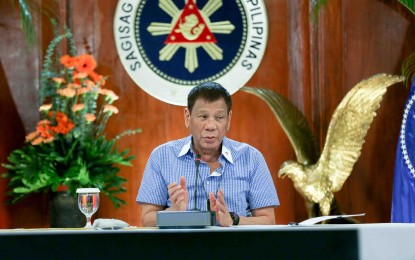
TALK TO THE NATION. President Rodrigo Roa Duterte talks to the people after holding a meeting with the Inter-Agency Task Force for the Management Emerging Infectious Diseases (IATF-MEID) core members at the Malago Clubhouse in Malacañang on July 15, 2020. (Simeon Celi Jr./Presidential photo)
MANILA – After a month of being under the most restrictive enhanced community quarantine (ECQ) due to a spike in coronavirus disease (Covid-19) cases, Cebu City has eased to a less restrictive modified ECQ from July 16 to 31.
President Rodrigo Duterte decided to downgrade the quarantine classification in Cebu City, Presidential Spokesperson Harry Roque said in a televised meeting with members of the Inter-Agency Task Force for the Management of Emerging Infectious Diseases (IATF-EID) aired late Wednesday night.
According to Roque, the National Capital Region (NCR) or Metro Manila will remain under general community quarantine (GCQ).
He said the President initially agreed with the recommendation of the University of the Philippines (UP) to revert NCR to modified ECQ but changed his mind after Metro Manila mayors vowed to implement more proactive restrictions under GCQ.
“There was a recommendation from UP to revert Metro Manila to MECQ to slow down the spread of the disease. At first, the President agreed but our chief implementer (Carlito Galvez Jr.) and our Secretary of Interior (Eduardo Año) appealed to reconsider because our Metro Manila mayors vowed to strictly enforce localized lockdowns, enhance testing, tracing, and treatment, and implement expanded restrictions under GCQ. So the President agreed not to revert Metro Manila to MECQ for the next two weeks,” Roque said in Filipino.
He warned that there is still a possibility that Metro Manila could revert to MECQ if the situation worsens.
He also urged the public to help the government prove that Covid-19 cases in the country would not swell to 80,000 by July 31 as indicated by UP researchers.
"It's correct to encourage each other to take all steps to make sure the 80,000 Covid-19 cases projection doesn't come true by July 31," he said.
Duterte also placed the following areas under GCQ: Laguna, Cavite, and Rizal for Region 4-A (Calabarzon); Lapu Lapu City, Mandaue City for Region 7 (Central Visayas), Ormoc City, Southern Leyte, Zamboanga City, Butuan City, Agusan del Norte and Basilan.
The cities of Talisay, Minglanilla, and Consolacion in Cebu province will also under be under GCQ.
Areas under “medium-risk” modified general community quarantine (MGCQ) are: Cordillera Administrative Region (CAR) – Benguet, Baguio City; Region 1 (Ilocos region) – Ilocos Sur, Pangasinan, Ilocos Norte, La Union, Dagupan City; Region 2 (Cagayan Valley) – Cagayan, Isabela, Nueva Vizcaya; Region 3 (Central Luzon) – Bataan, Nueva Ecija, Pampanga, Bulacan, Tarlac, Zambales, Angeles City; Region 4-A (Calabarzon) – Batangas, Quezon, Lucena City; Region 4-B (Mimaropa) – Oriental Mindoro, Occidental Mindoro, and Puerto Princesa City.
Also under medium-risk MGCQ are: Albay, Masbate, Camarines Norte, Camarines Sur, Catanduanes, Sorsogon, Naga City for Region 5 (Bicol); Iloilo, Negros Occidental, Capiz, Antique, Aklan, Guimaras, Iloilo City, Bacolod City for Region 6 (Western Visayas); Negros Oriental, Bohol, Cebu Province for Region 7 (Central Visayas); Western Samar, Leyte, Biliran, Tacloban City for Region 8 (Eastern Visayas); Zamboanga del Sur, Zamboanga Sibugay, Zamboanga del Norte for Region 9 (Zamboanga); Misamis Occidental, Bukidnon, Lanao del Norte, Cagayan de Oro City, Iligan City for Region 10 (Northern Mindanao); Davao Oriental, Davao del Norte, Davao del Sur, Davao de Oro, Davao City for Region 11 (Davao region); Sultan Kudarat, Cotabato, South Cotabato, General Santos City for Region 12 (Soccsksargen); Lanao del Sur, Maguindanao for BARMM; and Agusan del Sur, Dinagat Islands, Surigao del Norte, and Surigao del Sur Region 13.
The rest of the country will remain under “low-risk” MGCQ until July 31.
Earlier, Roque said present data shows that Metro Manila may not downgrade to the MGCQ as case doubling rate and critical care capacity of the region do not suggest an easing of quarantine protocols.
Metro Manila mayors have recommended that NCR be placed under “hybrid” GCQ amid the rising number of Covid-19 cases in the past weeks.
In a hybrid GCQ, movement of people will be restricted but economic activity will continue, provided that the private sector will take “equal responsibility” for containing the spread of the virus.
The public is still encouraged to strictly observe minimum health and safety standards such as physical distancing, wearing of face masks, and frequent handwashing to minimize the risk of catching or spreading the disease.
As of July 14, there are a total of 58,850 confirmed Covid-19 cases in the country, of which 20,976 are recoveries and 1,614 are deaths. (PNA)
